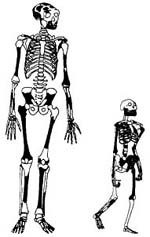"Out of Africa" Theory of Human Evolution In; Ancestral Eve Out

The analysis, published in the January 2000 issue of Molecular Biology and Evolution, is the first to examine the full spectrum of paleontological, archeological, and genetic evidence available, each reflecting a different part of the puzzle of human origins. By estimating the ranges of error in the different types of evidence, the researchers were able to narrow down the common, overlapping areas of agreement to construct an explanation that disproves some recent high-profile theories and supports one of the oldest modern versions of the origin of Homo sapiens.
"All the available evidence supports an 'Out of Africa' theory, that humans first evolved in Africa about 2 million years ago, then spread to other regions of the world," says John Hawks, first author of the paper and now an assistant professor of anthropology at the University of Utah (Salt Lake City). "This original population lived before humans colonized regions outside of Africa. In fact, it was the act of becoming human that made these colonizations possible."
Examining the anatomical evidence, the authors, including UM anthropologist Milford Wolpoff, conclude that a "genetic revolution" took place in a small group isolated from other australopithecines. "The earliest H. sapiens remains differ significantly from australopithecines in both size and anatomical details," notes Wolpoff. "Insofar as we can tell, these changes were sudden and not gradual."

The dramatic size difference between the first members of early Homo sapiens and their australopithecine predecessors and contemporaries is shown in this correctly scaled comparison of the reconstructed skeletons of two women: Lucy, a 3-million-year-old australopithecine from Ethiopia who stood about three-and-a-half feet tell; and ER 1808, a 1.6-million-year-old woman of our species from Kenya who stood 5 feet 9. Australopithecine contemporaries of ER 1808 were as small as Lucy.
According to the researchers, the available genetic data do not disprove a simple model of exponential population growth following a bottleneck 2 million years ago and extending through the Pleistocene Epoch, when ice covered much of North America and Europe. But they are incompatible with a more recent population-size bottleneck.
"Many details of subsequent human evolution over the period of the ice ages remain unclear, but one certain finding from both anthropological and genetic data is that there was no later time when the size of the human species became small again," says Hawks. "So the 'Eve theory' of modern human origins, which states that modern human populations very recently arose as a new African species that replaced all other indigenous peoples such as Neanderthals, can be put to rest."
Co-authors of the study with Hawks and Wolpoff are Keith Hunley of UM's Department of Anthropology and Sang-Hee Lee of the Department of Biosystems Science at the Graduate University for Advanced Studies (Hayama, Kanagawa, Japan).
For more information: Milford H. Wolpoff, Department of Anthropology, University of Michigan, Ann Arbor, MI 48109-1382. Tel: 313-475-3291. Email: wolpoff@umich.edu.
